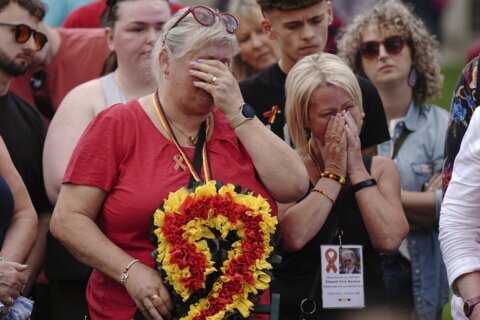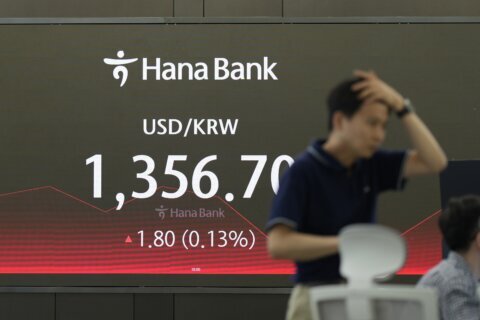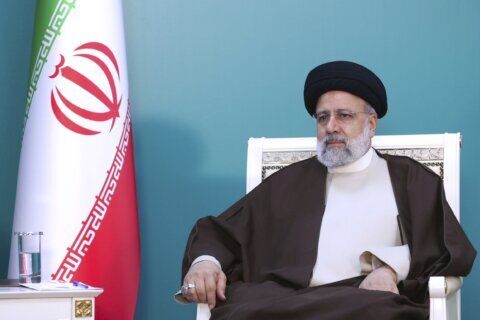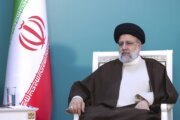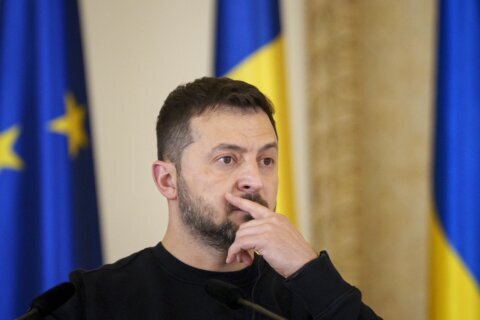
BRUSSELS (AP) — For the first time, Ukrainian President Volodymyr Zelenskyy joined a meeting of more than 50 defense leaders from around the world, making a personal pitch Wednesday for military aid in the face of lagging political support in the United States and new pressure on allies to send weapons to bolster Israel’s war with Hamas.
His presence underscored growing concerns about cracks in what has been staunch international backing for Kyiv in its war against Russia’s invasion, and worries that Ukrainian forces haven’t made measurable progress in the counteroffensive as winter closes in.
Asked about concerns that Ukraine could get less military support because of the Mideast conflict, Zelenskyy said there is a “very understandable volume” that the U.S. and Europe can provide. Zelenskyy said he has asked that question himself, adding he thinks nobody really knows but he is still assuming U.S. and European support.
As for the Israel complication, “of course, everybody’s afraid, and I think also Russia’s counting on it, on dividing support,” Zelenskyy said in remarks at a news conference with Belgian Prime Minister Alexander De Croo.
U.S. Defense Secretary Lloyd Austin dismissed suggestions that support to Kyiv could suffer as the U.S. sends help to Israel.
“In terms of our ability to continue to support both the efforts in Ukraine and support the efforts in Israel as well — absolutely, we can do both and we will do both,” Austin said.
The meeting of the Ukraine Defense Contact Group, hosted by the U.S., comes as Ukraine is desperately seeking more weapons to help its troops regain ground from Russian forces before the muddy weather sets in. But political chaos in Congress has stalled approval of new Ukraine funding, and there has been growing opposition among some lawmakers to any increase in spending.
Speaking as he entered NATO headquarters, Zelenskyy noted the Israel war and said Ukrainians understand such tragedy. But he was also quick to detail Ukraine’s ongoing need for air defense systems and long-range missiles “to push Russia out of our land.”
“Next Monday, we will mark the 600th day of our resistance to Russia’s full scale aggression against our people, against Ukraine. And today, no one can say for sure how many more days we will have to defend our independence and to defend our identity,” Zelenskyy told the gathering at the opening of the meeting. “But we can already say several things which I think are important. First, Putin will not achieve Ukraine. Second, Russia cannot afford a new arms race. And third, democracy can win this battle.”
Austin told reporters traveling with him to Brussels that support for Ukraine continues unabated. He said a number of allies will announce they are sending additional weapons and other support to Kyiv. A key demand has been more air defense systems and munitions.
“The energy, in my view, is still there,” said Austin. “And I will reassure them that we remain committed to this.”
Austin also announced that the U.S. will take on a new leadership role in the broader effort to build Ukraine’s air force, specifically with F-16 fighter jets. He said the U.S. will co-lead a coalition along with Denmark and Netherlands, and will help organize donation of the aircraft, plans to sustain and maintain them and pilot training. That training has already started in the U.S. Austin said the training will likely take months and it may not be until next spring that Ukraine is operating the F-16s.
He asserted that Ukraine is making steady progress in the war. And he said allies are focusing not only on meeting Kyiv’s immediate needs but also on setting up plans to coordinate investments in Ukraine’s future force.
This was also the first Ukraine contact group meeting for Air Force Gen. CQ Brown, chairman of the U.S. Joint Chiefs of Staff, who started the job October 1. He said that additional commitments of weapons and conversations with allies convinced him “we’re putting Ukraine in a good spot” ahead of the winter fight.
The contact group is the main forum for raising contributions of weapons, equipment and training for Kyiv’s war effort. It meets about once a month, in person and virtually, and this is the 16th gathering.
Zelenskyy, who was greeted with applause as he entered the building, went immediately into a private session with Austin and Brown.
Speaking to reporters as he came in, Zelenskyy reiterated his country’s need for long-range missiles and ammunition.
“It’s very important that there are priorities. There are air defense systems. These are not just basic words. These are very concrete things and we need them,” Zelenskyy said.
Following that meeting, the 31 allies and Ukraine will take part in the first NATO-Ukraine Council at this level. The forum was formally established in July as part of efforts to bring Kyiv closer to the alliance. It allows NATO and Kyiv to discuss issues of common interest and concern.
The new package of U.S. aid includes AIM-9M missiles that Austin said will be used with a new surface-to-air missile defense system that the U.S. will soon deliver to Ukraine. In addition, the U.S. will provide counter-drone systems, munitions for the High Mobility Artillery Rocket System (HIMARS), artillery, electronic warfare equipment, demolition munitions, anti-armor systems and more than 16 million rounds of small arms ammunition.
The weapons are provided under presidential drawdown authority, so will be taken from Pentagon stocks and sent to the battlefield.
Later in the day Zelenskyy spoke by video to U.S. Treasury Secretary Janet Yellen and other top finance officials who met to discuss economic aid to Ukraine at the World Bank and International Monetary Fund annual meetings in Marrakech, Morocco. Yellen said she believes there is bipartisan support to fund Ukraine and provide resources to Israel, but added, “I can’t tell you precisely what the timetable is for getting this done”.”
Other nations also announced new support for Ukraine.
Belgium’s defense minister, Ludovine Dedonder, said Belgium will deliver F-16s to Ukraine and provide technical and maintenance assistance, but they won’t be sent before 2025. She said the number of aircraft will depend on how soon Belgium gets its new F-35s.
Dutch Defense Minister Kajsa Ollongren said the Netherlands will make three unarmed MQ-9 Reaper drone systems available to monitor NATO’s eastern flank for at least six months beginning in the first quarter of 2024. The drones will operate out of Campia Turzii airbase in Romania and be used to gather intelligence.
___
Associated Press writers Raf Casert, David McHugh in Frankfurt, Germany, and Tara Copp in Washington contributed from to this report.
___
Follow AP’s coverage of the war in Ukraine at https://apnews.com/hub/russia-ukraine
Copyright © 2024 The Associated Press. All rights reserved. This material may not be published, broadcast, written or redistributed.


